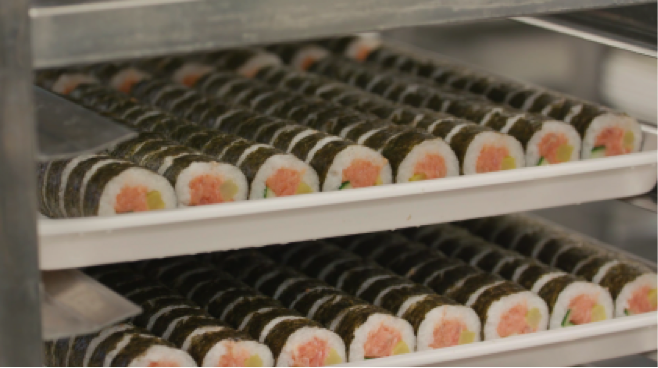“China’s demand for shrimp, salmon and tuna have put Japan in a disadvantageous position.”
The first kaiten-zushi (conveyor-belt sushi) restaurant to open in Japan was Mawaru Genroku Sushi in Osaka in 1958. More than 60 years later, inexpensive kaiten-zushi has become an indispensable part of life for Japanese people of all ages.
In 2020, seafood supplier Maruha Nichiro asked 13,595 Japanese where they preferred to eat sushi – an overwhelming 77.4 per cent replied that they ate at kaiten-zushi restaurants.
When asked which toppings they favoured, 47.3 per cent of respondents answered salmon, well ahead of akami (lean tuna) in second place with 33.5 per cent. Salmon has remained top choice for the last nine consecutive years since the 2012 survey.
Now however, there are fears for the future of the niche industry as Japanese magazine Weekly Playboy carries the headline, “Kaiten-zushi in a fight for survival!?”
In the article, trading firm director Momoo Odaira is quoted as saying, “The price of salmon roe, both from Russia and Alaska, as well as from Chile and Norway has risen by 30 per cent, and some types by as much as 50 per cent.”
The spike in prices is partially linked to the disastrous series of red tides experienced off of Hokkaido in the autumn.
Read more: Prices in Japan surge as red tides devastate marine life in Hokkaido
Prices spike
Last October, Kura Sushi, one of the three major chains in Japan, raised its single-portion servings of ikura (salmon roe) by 10 yen. In November, the Sushiro chain boosted its price from 100 to 150 yen per serving.
In general, the conveyor belt chains in Japan operate based on a cost-price ratio of from 45 to 50 per cent, considerably higher than other restaurants whose ratio averages around 30 per cent. This means that kaiten-zushi restaurants are much more vulnerable to price increases of fish and other sea foods, their basic material.
The instability of seafood prices is particularly difficult for the major kaiten-zushi chains, because they tend to set prices in round figures, such as 100, 200 and 300 yen per plate.
Not just salmon
What’s responsible for the recent changes? A key factor may be increasing instability in the supply chain as red tides and other natural disasters become more and more common. This problem is exacerbated by the fact that demand is booming in many commodities post covid at a point when total biomass is down for farmed species such as salmon and trout.
Meanwhile, procurement costs from imports items harvested in more distant parts of the world have increased.
For example, much of the kuro maguro (bluefin tuna) consumed in Japan is raised in fish farms in the Mediterranean. From May 2021 its price began soaring and by the end of December the cost had risen between 25 to 35 per cent. Prices for around 60 percent of yellowtail tuna, another popular variety, also increased.
According to data from the Japanese government’s Fisheries Agency, as of last November, the wholesale market prices of aji (Caranginae) had increased by 129 per cent; cuttlefish, 135 per cent; and sanma (Pacific saury), a whopping 192 per cent, vis-a-vis their average prices in the same month over the five-year period from 2016 to 2020.
Botan ebi (botan shrimp) from Russia has increased 2.5 fold in the past year, and ama ebi (Alaskan pink shrimp) rose 3.5 fold.
Chinese demand
As sushi attracts more fans abroad, Japanese consumers must now compete for supply in a global market.
“Kaiten-zushi has been experiencing a boom in demand overseas, particularly in China and North America,” Odaira is quoted as saying. “China’s demand for shrimp, salmon and tuna have put Japan in a disadvantageous position. Chinese companies have also cornered the market on other types of fish such as flounder, so Japan has to buy from the Chinese.”
“We opened our first branch in Guangzhou City last September, and a second branch in November,” says Kazunari Matsuda, president of the Guangzhou affiliate of Sushiro. “Since their openings, they’ve been filled to capacity. Customers like not just regular items like tuna and salmon but sea urchin, flounder and salmon roe are also popular. More people have even started to favor cuts that they’ve avoided in the past.”
The least expensive dishes are priced at 10 Chinese yuan, or about 170 Japanese yen – slightly above the going rate in Japan. Matsuda says that local customers do not regard a sushi meal as a special treat, but rather view it in the same light as dining in other restaurants.











